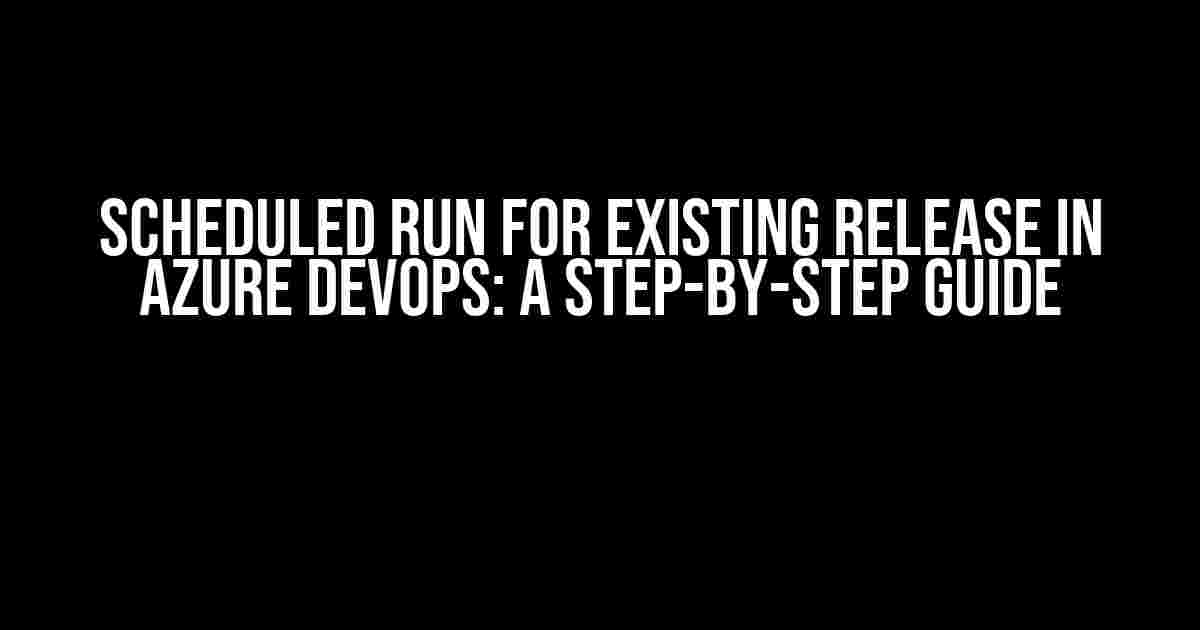Are you tired of manually triggering releases in Azure DevOps? Do you want to automate the release process to save time and increase efficiency? Look no further! In this article, we’ll show you how to schedule a run for an existing release in Azure DevOps, so you can sit back, relax, and let the magic happen.
Why Schedule a Run for an Existing Release?
Scheduling a run for an existing release in Azure DevOps offers several benefits, including:
- Increased efficiency: By automating the release process, you can save time and focus on more critical tasks.
- Reduced errors: Manual triggering of releases can lead to errors, which can be avoided by scheduling a run.
- Improved consistency: Scheduled runs ensure that releases are deployed consistently, reducing the risk of human error.
- Enhanced collaboration: Scheduling a run allows multiple teams to work together seamlessly, ensuring that everyone is on the same page.
Prerequisites
Before we dive into the process, make sure you have:
- An Azure DevOps account with the necessary permissions.
- An existing release pipeline in Azure DevOps.
- A valid Azure subscription.
Scheduling a Run for an Existing Release
Now that we’ve covered the prerequisites, let’s get started with scheduling a run for an existing release in Azure DevOps:
Step 1: Navigate to the Release Pipeline
Login to your Azure DevOps account and navigate to the release pipeline you want to schedule a run for.
https://dev.azure.com/{your-organization}/{your-project}/_releasePipelineViewStep 2: Click on the “…” Button
In the top-right corner of the release pipeline, click on the “…” button to open the context menu.

Step 3: Select “Schedule Release”
In the context menu, select “Schedule Release” to open the scheduling dialog box.

Step 4: Configure the Schedule
In the scheduling dialog box, configure the schedule according to your requirements:
| Field | Description |
|---|---|
| Schedule type | Select “Once” to schedule a one-time run or “Recurring” to schedule a recurring run. |
| Start time | Select the start time for the scheduled run. |
| Time zone | Select the time zone for the scheduled run. |
| Release options | Select the release options, such as the environment and artifact, to be used for the scheduled run. |

Step 5: Save the Schedule
Once you’ve configured the schedule, click “Save” to save the changes.
Troubleshooting Common Issues
If you encounter any issues while scheduling a run for an existing release, try the following troubleshooting steps:
Issue 1: Insufficient Permissions
If you encounter an “Insufficient permissions” error, check that you have the necessary permissions to schedule a run for the release pipeline.
Issue 2: Invalid Schedule Configuration
If you encounter an “Invalid schedule configuration” error, review your schedule configuration and ensure that it is valid.
Issue 3: Release Pipeline Not Found
If you encounter a “Release pipeline not found” error, ensure that you have navigated to the correct release pipeline.
Conclusion
Scheduling a run for an existing release in Azure DevOps is a straightforward process that can help you automate your release pipeline and increase efficiency. By following the steps outlined in this article, you can ensure that your releases are deployed consistently and reliably.
Remember to save time and reduce errors by scheduling a run for your existing release today!
FAQs
Q: Can I schedule a run for a specific environment?
A: Yes, you can schedule a run for a specific environment by selecting the environment in the release options section of the scheduling dialog box.
Q: Can I cancel a scheduled run?
A: Yes, you can cancel a scheduled run by navigating to the release pipeline and clicking on the “…” button to open the context menu, then selecting “Cancel scheduled run.”
Q: Can I view the scheduled run history?
A: Yes, you can view the scheduled run history by navigating to the release pipeline and clicking on the “…” button to open the context menu, then selecting “View scheduled run history.”
We hope this article has helped you schedule a run for an existing release in Azure DevOps. If you have any further questions or need assistance, please don’t hesitate to reach out.
Happy automating!
Frequently Asked Question
Got questions about scheduled runs for existing releases in Azure DevOps? We’ve got answers!
What is a scheduled run for an existing release in Azure DevOps?
A scheduled run for an existing release in Azure DevOps is a feature that allows you to trigger a deployment of your release at a specific date and time. This way, you can plan and automate your deployments in advance, making it easier to manage your release lifecycle.
How do I schedule a run for an existing release in Azure DevOps?
To schedule a run for an existing release in Azure DevOps, go to your release pipeline, click on the three dots at the top right corner, and select “Schedule release”. Then, choose the environment you want to deploy to, select the date and time, and click “Schedule”. Easy peasy!
Can I schedule a run for an existing release in Azure DevOps using YAML?
Yes, you can! Azure DevOps allows you to schedule a run for an existing release using YAML. You can add a “schedules” section to your YAML file, specifying the trigger and schedule details. This way, you can automate your deployments and manage your release lifecycle with code.
What happens if I update my release pipeline after scheduling a run in Azure DevOps?
If you update your release pipeline after scheduling a run in Azure DevOps, the scheduled run will use the updated pipeline configuration. This means that any changes you make to your pipeline, such as new tasks or updated variables, will be reflected in the scheduled run.
Can I cancel or edit a scheduled run for an existing release in Azure DevOps?
Yes, you can! If you need to cancel or edit a scheduled run for an existing release in Azure DevOps, go to your release pipeline, click on the three dots at the top right corner, and select “Scheduled releases”. From there, you can cancel, edit, or delete your scheduled runs as needed.


